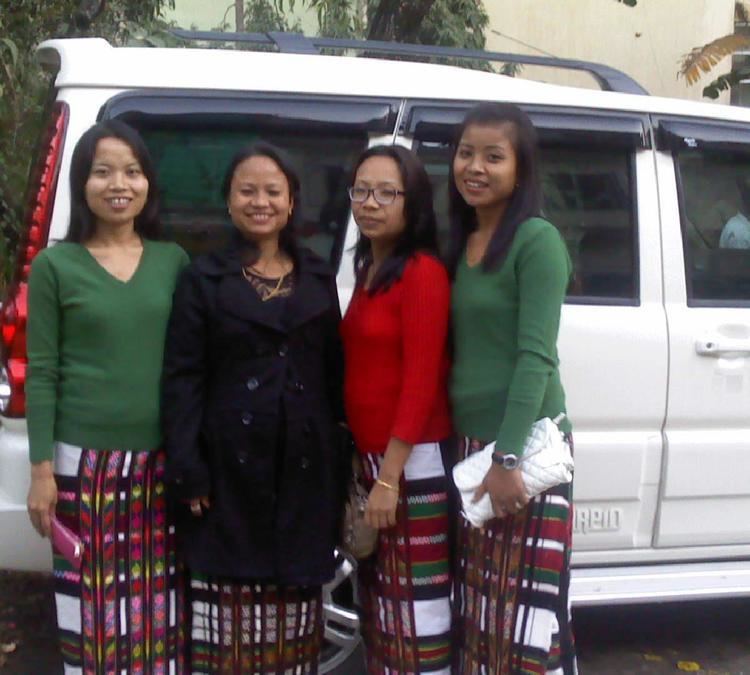 | ||
The Faihriem, or Saihriem, is a small regional clan located in the Indian states of Assam and Mizoram. It is considered a sub-tribe of the Hmar tribe. However, some believe that the Faihriem tribe is distinct from the Hmar.
Contents
The tribe is recognised by the Constitution of India as Sairhem under Any Kuki tribes in Assam [In accordance with The Scheduled Castes and Scheduled Tribes Orders (Amendment) Act, 1976.], Meghalaya [In accordance with The Scheduled Castes and Scheduled Tribes Orders (Amendment) Act, 1976 and The Constitution (Scheduled Tribes) Order (Amendment Act, 1987] and Mizoram [In accordance with The Scheduled Castes and Scheduled Tribes Lists (Modification) Order, 1956 and as inserted by Act 81 of 1971]
Origin of Sub-Clan Names
A tradition from the Faihriem culture is a central aspect of the origin lore for sub-clan names. According to this tradition, one must throw a spear up in the air to define a location for new settlement. If the spear hits the ground pointing straight down, it is a good omen and the place should be selected for settlement.
One legend that explains the meaning of the clan names mentions this spear-tossing tradition. A woman, from a clan that settled around a thrown spear, asked her daughter to go and give meat to her uncles. This girl had many uncles so she asked her mother who should receive the meat. Her mother listed the uncles by their settlement and individual traits. The story states that the sub-clans descended from these uncles and became known by the names their niece had called them.
Another legend tells about the origins of the Khawlhring and Vangchhia clans. The legend says a man named Chunthang had a strange dream, which in the morning he related to his elder brother Saivate. Saivate rebuked him for having a dream, saying, "We, the Faihriems, never have dreams." Because of his dream, Chunthang was considered unclean and left home to dwell with another tribe, the Biate. He was known as a man of good character, a quality which earned him the hand of the Biate princess, Lazai. They were married, but none of their children were able to survive past infancy. One night, Chunthang was told in a dream that the next child they had could survive if born in another village. So, when the time for the delivery of this next child arrived, Lazai was taken to the village of the Thiek clan, where she delivered a healthy baby boy named "Khuolhring". This boy was the progenitor of the Khawlhring sub-clan. When Lazai became pregnant again, Chunthang had another dream telling him to keep the child beneath the "vang" tree near the house. This child was named "Vangsie" or Vanchhia, and was the progenitor of the Vangchhia sub-clan. The Ngente, Jongte, Bawlte, and Zawhte clans are said to be descended from Chunthang's younger brother, Ngendum.
Area
The Faihriems disperse in all directions. Some groups moved to Manipur and stayed with the Khawsak-speaking people (Khawsak is a dialect of the Hmar language). Some groups reached the North Cachar Hills and adopted Biete and Thiek dialects; still others remained in the states of Tripura and Mizoram. However, a group consisting of people from the Saivate, Hmuntha, Seiling, Tuollai and Thlanghnung (Sim Saihriem, Mirawngngam, Tuiruong Saihriem) and Aimol sub-clans settled the plain areas of Cachar and established the Saihriem village there. They lived independently without intermingling with other clans for many years. This group was unaffected by other cultures and is likely the most similar to the original Faihriem clan.
Language
Most of the Faihriems today speak either Hmar or Mizo as their first language. However, the Faihriems of Cachar District of Assam, called Kuki by the Bengalis, still speak the Saihriem dialect as their first language. (The term Kuki was never used by them to identify themselves.) There are presently five villages where Saihriem is spoken: Noxsatilla (Ningpu), Baghbahar, Luipi, Nagathol and Balisor in the Cachar District.
Culture (festival and religion)
The Faihriem culture is patriarchal. The male, the father, is the head of the family, the supreme authority, and makes the final decisions for the family. The line of descent is traced through the father only.
The culture is enriched with a good number of tribal songs and dance forms. Musical instruments such as the khuong (a kind of drum), the tawtawrawt (a flute), and the rawsem (a bamboo flute) are played during their dance and song performances, especially during festivals. One such festival is the Sikpuiruoi on the 5th of December. It celebrates the season when all the crops and paddy have been gathered. Dances are also a large part of the festivals. Some of the dances are the harvest dance, known as Chawnglam (lit. "Chawng" - owner; and "lam" - dance); the bamboo dance, known as Sareltawk (lit. "sarel" - pestle and "tok" - to strike); and a hunting dance, known as Salulam (lit. "salu" - hunted and "lam" - dance). Although these dances are still well known in Faihriem society, they have rarely been practiced in recent times due to the effects of modernization and Christianity.
Before the introduction of Christianity, the Faihriem people were animists. They performed worship rituals like "Koloirobong," which was performed in the evening to satisfy all evil spirits that may be nearby, and "Zingdevan," the worship of the sun by sacrificing animals such as the cock and pig. However, there is now at least one Christian church in each village, and the traditional Faihriem practices are no longer performed.
History
In the past, the clan was known as Mivam ("Mi" means people, and "Vam" means white or pure, thus "white or pure people") which bore the same meaning as Faihriem ( "Fai" means pure, "Hriem" means people, thus "pure or clean people" ). The Faihriem had many famous and great chiefs: namely, Salawnkhar, Tusing, Tanhril Saivate, Lersi, Lalmichhinga (the last chief of Khualhring Kingdom), Laidumbela, (Chief of Vangchhia clan), Zakuala, Hauchema, and Vanhnuaihauchema.
